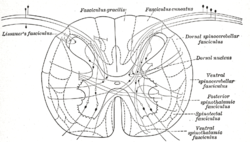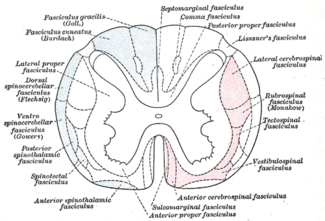Posterolateral tract
| Arcuate nucleus (medulla) | |
|---|---|
| Identifiers | |
| NeuroLex ID | Lissauers tract |
| TA | A14.1.02.228 |
| FMA | 72616 |
| Anatomical terms of neuroanatomy | |
| Posterolateral tract | |
|---|---|
 Diagram showing a few of the connections of afferent (sensory) fibers of the posterior root with the efferent fibers from the ventral column and with the various long ascending fasciculi. (Lissauer's fasciculus visible in upper left.) | |
 Diagram of the principal fasciculi of the spinal cord. (Lissauer's fasciculus visible in upper right.) | |
| Details | |
| Latin | tractus posterolateralis |
| Identifiers | |
| Gray's | p.762 |
| Dorlands /Elsevier | t_15/12817084 |
| TA | A14.1.02.228 |
| FMA | 72616 |
| Anatomical terminology | |
The posterolateral tract (fasciculus of Lissauer, Lissauer's tract, tract of Lissauer, dorsolateral fasciculus, dorsolateral tract, zone of Lissauer) is a small strand situated in relation to the tip of the posterior column close to the entrance of the posterior nerve roots. It is present throughout the spinal cord, and is most developed in the upper cervical regions.
Composition and Path
The posterolateral tract contains centrally projecting axons from dorsal root ganglion cells carrying pain and temperature information (location, intensity and quality). These axons enter the spinal column and ascend or descend one or two spinal segments in this tract before penetrating the grey matter of the dorsal horn, where they synapse on second-order neurons. The axons of these second-order neurons cross the midline and ascend in the anterolateral quadrant of the contralateral half of the spinal cord, where they join the spinothalamic tract. The second-order neurons ultimately synapse on neurons in the ventral posterior lateral nucleus (VPL) of the thalamus.
It consists of fine fibers which do not receive their myelin sheaths until toward the close of fetal life.
In addition it contains great numbers of fine non-myelinated fibers derived mostly from the dorsal roots but partly endogenous in origin.
These fibers are intimately related to the substantia gelatinosa[1] which is probably the terminal nucleus.
The non-myelinated fibers ascend or descend for short distances not exceeding one or two segments, but most of them enter the substantia gelatinosa at or near the level of their origin.
Clinical significance
During a complete occlusion of the ventral artery of the spinal cord, it is the only tract spared along with the dorsal columns. The posterolateral spinal tracts are involved with neurological deficits seen in pernicious anemia.
Eponym
The tract of Lissauer was named after German neurologist Heinrich Lissauer (1861-1891).
References
This article incorporates text in the public domain from the 20th edition of Gray's Anatomy (1918)
- ↑ Wall PD, Lidierth M, Hillman P (December 1999). "Brief and prolonged effects of Lissauer tract stimulation on dorsal horn cells". Pain 83 (3): 579–89. doi:10.1016/S0304-3959(99)00170-0. PMID 10568867.
External links
| ||||||||||||||||||||||||||||||||||||||||||||||||||||||||||||||||||||||||||||